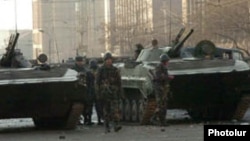Seyran Ohanian, a former defense minister poised to join the Armenian opposition, has denied any responsibility for the deadly 2008 crackdown on opposition protesters in Yerevan that followed a disputed presidential election.
Ohanian’s alleged role in those events came under renewed spotlight after he decided to challenge the Armenian government in the upcoming general elections and began increasingly criticizing it last month. He warned last week of a risk of “bloody revolutionary upheavals” in the country.
Armenia went through such strife in the wake of the February 2008 presidential election that formalized the handover of power from then President Robert Kocharian to Serzh Sarkisian. Ohanian was the chief of the Armenian army’s General Staff at the time.
Tens of thousands of supporters of the main opposition candidate, Levon Ter-Petrosian, took to the streets of Yerevan to demand a rerun of the vote which they believed was rigged by the authorities. Riot police broke up their nonstop sit-in in the city’s Liberty Square on March 1, 2008.
Many Ter-Petrosian supporters responded by barricading themselves elsewhere in downtown Yerevan later that day. Eight protesters and two police personnel were killed in ensuing clashes with security forces. Citing the violence, Kocharian declared a state of emergency and ordered Armenian army units into the capital.
In a March 2 televised address to the nation, Ohanian warned Armenians against attempting to stage fresh anti-government protests. He was appointed as defense minister shortly after Sarkisian was sworn in as president in April 2008.
“The Armed Forces played no role in the March 1 [unrest,]” Ohanian insisted on Saturday. “They just took over the protection of important facilities in Armenia’s capital on March 2. It’s clear from [the 2008 video] that I asked our people to show tolerance.”
Ter-Petrosian loyalists have for years alleged that the Armenian military began moving into Yerevan even before Kocharian formally declared the three-week emergency rule. Some of them claim that Kocharian issued a secret order to the military one week before the crackdown.
“There is ample video and photo proof that army units were deployed in Yerevan on that day [March 1,]” said Arakel Semirjian, an activist leading a non-governmental organization called March 1.
“The very fact that the army got into the city enabled armed gangs and government forces to act with impunity,” Semirjian told RFE/RL’s Armenian service (Azatutyun.am). Ohanian’s denials are therefore a “lie,” he said.
Ohanian, who was sacked in October 2016, now looks set to join a new opposition alliance which is being formed by several opposition politicians. One of them, Vartan Oskanian, served as foreign minister during the dramatic events of 2008.
Oskanian made a televised statement in the presidential palace in Yerevan just hours before the March 1 bloodshed. He warned Ter-Petrosian to end the street protests.
Oskanian has repeatedly defended his actions. Speaking to reporters in March 2016, he insistedd that he tried to avert the violence. But he also said: “The authorities should not have allowed such a thing to happen. I was part of those authorities.”






Facebook Forum